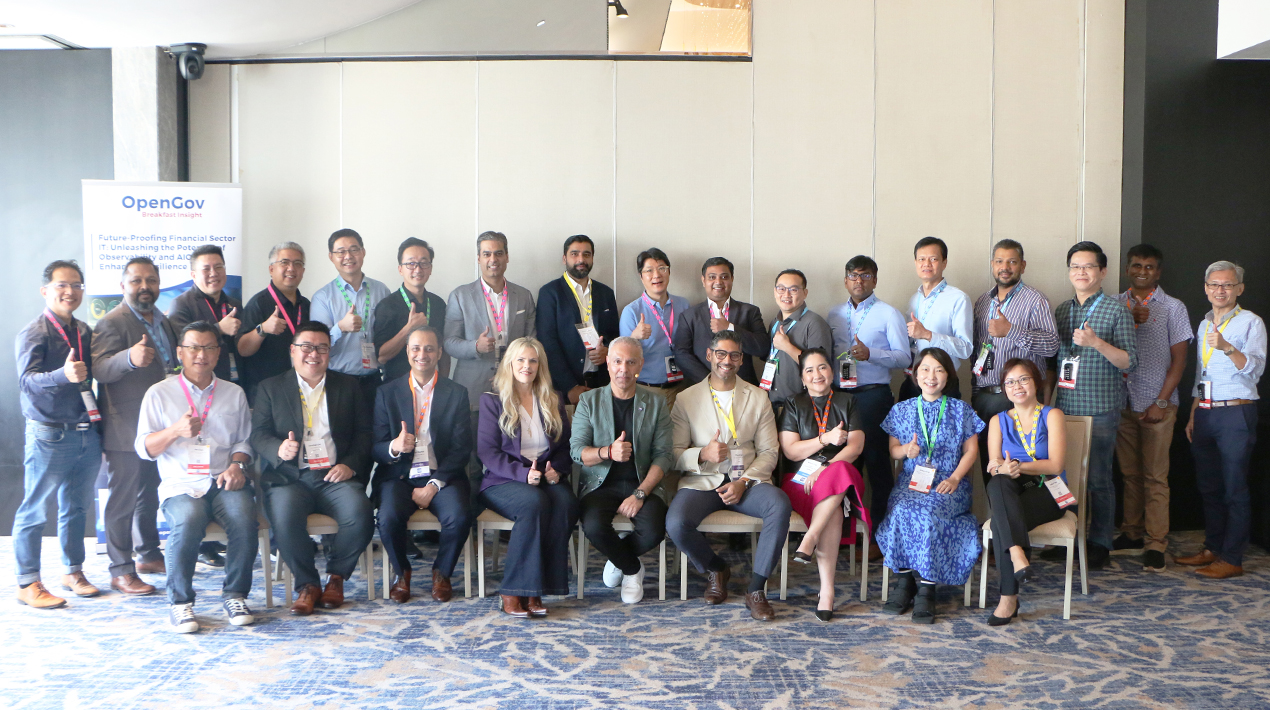
|
Getting your Trinity Audio player ready...
|
The era of automation is far from being a novel concept, with its roots tracing back a long time. Notably, innovations like self-operating robots and driverless vehicles, which once represented cutting-edge technology, have continuously evolved and are currently undergoing significant modifications and revolutions.
As the world embraces automation in various forms, the IT industry is at the forefront of these advancements, diligently crafting infrastructure using a cloud-native approach to support and optimise these automated technologies for enhanced performance and efficiency.
As is often the case with innovations, the adoption of a cloud-native approach is not a straightforward endeavour, as it comes with its unique set of challenges. IT teams frequently grapple with the intricacies of managing complex multi-cloud environments, which have become the primary repository for mission-critical data.
The journey is rife with complexities ranging from system performance and security vulnerabilities to application-related concerns. Consequently, teams often find it challenging to promptly detect and prioritise cybersecurity threats and performance issues, leading to potential disruptions or security breaches that may impact applications.
The complexity of monitoring and managing various devices on on-premises and hybrid multi-cloud systems can hamper the entire technology transformation journey. IT teams need the latest technology to ensure that all data and information is available in the right place at the right time.
The financial sector’s computing environment is characterised by its extensive reach, complexity, and critical significance, necessitating an equivalent level of visibility and functionality to maintain seamless system operations. Nonetheless, these are central challenges encountered by numerous organisations across a spectrum of industries.
The genuine concern lies in the potential consequences of leaving such issues unattended, as they can lead to the unauthorised extraction of valuable business data by irresponsible actors. This, in turn, poses a substantial risk to the company’s reputation and can result in substantial financial losses.
Research findings indicate that a significant 61% of enterprise IT leaders encounter challenges when it comes to addressing “blind spots” in monitoring, particularly within their multi-cloud environments, exacerbating the issue at hand. These elusive “blind spots” can lead to heightened risks due to the lack of an effective method for comprehensively monitoring and understanding the entirety of their infrastructure.
To address the array of challenges outlined earlier, organisations are relying on Artificial Intelligence for IT Operations (AIOps) and Observability. Both of these approaches can autonomously detect and mitigate emerging issues concerning the infrastructure and applications within a cloud-native environment. In doing so, they assist organisations in sustaining peak performance, swiftly identifying cybersecurity threats, and ensuring uninterrupted business operations.
The OpenGov Breakfast Insight on 17 November 2023 at Voco Orchard Singapore discussed how financial institutions can gain real-time visibility over the entire IT ecosystem, enabling proactive monitoring, rapid troubleshooting, and informed decision-making to deliver uninterrupted and reliable services to their customers.
Opening Remarks

Mohit Sagar, CEO, and Editor-in-Chief of OpenGov Asia acknowledges that AIOps, with its emphasis on artificial intelligence (AI) and machine learning (ML), offers robust automation and analytics capabilities, serving as a valuable solution for tackling the intricacies of the contemporary IT landscape.
By the year 2024, over 30% of business leaders will find themselves heavily reliant on AIOps platforms, underlining the substantial role AIOps will play in assisting companies in the management and optimisation of their operations.
He is optimistic about the ongoing expansion of the AIOps market, with an anticipated annual growth rate of 15% from 2020 to 2025. This robust growth forecast underscores the growing significance of AIOps within the realm of information technology, with organisations spanning various sectors expected to increasingly embrace it as a means to enhance their operational efficiency and overall effectiveness.
Mohit also underscores the significance of observability within the realm of IT management strategy. Observability is an approach centred on the monitoring of crucial, pertinent, and pivotal aspects of system operations. This approach aids organisations in upholding visibility into the diverse facets of the performance and experience of their applications, infrastructure, and overall IT systems.
Observability empowers financial institutions with profound insights into intricate systems, enabling real-time monitoring and analysis of data. On the other side, AIOps leverages the capabilities of artificial intelligence (AI) and machine learning (ML) to automate IT operations. The combination creates a synergistic approach that facilitates proactive issue resolution and optimisation within the financial system.
Mohit stressed that a holistic IT management strategy incorporating AIOps offers numerous substantial advantages for a spectrum of organisations, particularly in the context of the fiercely competitive financial industry.
In an era where efficiency, security, and innovation are paramount, leveraging AIOps can empower these institutions to streamline operations, enhance cybersecurity, and stay ahead of the curve in a dynamic and fast-paced industry. AIOps not only offers a cutting-edge technological edge but also positions organisations to offer better services and navigate the complex landscape of financial services with confidence and success.
Mohit elaborates on the critical nature of uninterrupted operations, emphasising that any instance of system downtime or malfunction can lead to dire consequences. These repercussions extend beyond missed business opportunities and encompass substantial revenue losses. In the ever-evolving financial industry, both customers and policymakers place a premium on services that not only exhibit efficiency but also unwavering reliability.
“Ensuring uninterrupted service is critical to maintaining high levels of customer satisfaction, building and maintaining customer trust and ensuring customer loyalty,” Mohit affirms. “Maintaining a robust and resilient operational environment is paramount to meeting demands and ensuring the continued trust and satisfaction of stakeholders.”
Effective policies and sophisticated IT infrastructure management are critical foundations for achieving this. Financial institutions, as well as other organisations, must be prepared to face intense competition, and one of the keys to success is ensuring that their systems and services are always available and performing optimally.
Proactive monitoring and structured incident management are important strategies to ensure smooth service to create efficient operations. By leveraging the power of observability and AIOps, financial institutions can detect and address root causes, thereby reducing the ongoing impact on business operations.
AIOps in the financial sector offer a multitude of advantages, notably the enhancement of operational resilience within financial institutions. This, in turn, enables these organisations to provide their customers with optimal services, ensuring their competitiveness in an increasingly challenging business landscape.
“The implementation of AIOps equips institutions with the capacity to proactively detect, mitigate, and avert technical issues that might otherwise disrupt system and service performance, culminating in a seamless and dependable experience for their valued customers,” Mohit says. “This strategic advantage is pivotal for maintaining competitiveness in an ever more competitive landscape.”
Welcome Address

Andrea Webb, Chief Customer Officer, SolarWinds Inc, underscores the significant economic potential and stability of the Asia Pacific region, setting it apart from other global economic powerhouses like the United States and Europe.
Inflation emerges as a fundamental differentiator between the Asia Pacific region and its Western counterparts, as highlighted by Andrea. In comparison to the United States and Europe, the intensity of inflation in Asia is less pronounced. This distinction holds significant consequences, given that inflation can wield a substantial influence on the economic stability of a region.
Asia has managed to maintain price stability, with the latest inflation figures hovering just above 2%. This remarkable feat suggests that the Asia Pacific economy has been successful in preserving economic stability, a key indicator of its potential for continued growth.
Andrea highlights the trend of declining core inflation in most Asian countries, except Japan. This trend reflects the prudent management of inflation in many Asian nations, fostering an environment conducive to stable and sustainable economic expansion.
The optimistic economic outlook in the Asia Pacific region serves as a catalyst for innovation and adaptation within the financial sector to meet evolving societal needs. With ongoing economic growth, the financial sector is positioned for rapid development, necessitating a crucial shift toward digital transformation to align with this expansion.
Andrea underscores that digital transformation is not merely an option for the financial sector; it is an absolute necessity across all levels of the industry. Leveraging multi-cloud solutions, for instance, can enhance financial services, enabling providers to offer more responsive and reliable services to their customers.
“However, the use of multiple cloud platforms can introduce complexities and challenges. Managing infrastructures that overlap with one another can lead to issues in integration and coordination of operations,” Andrea explains. “Differences in infrastructure, security policies, data management, and technology architecture among various cloud providers can exacerbate these challenges.”
To address the complexities of multi-cloud management, effective strategies and tools are essential. Organisations need to invest in management platforms that can help handle multi-cloud infrastructure efficiently, automate processes, and monitor system performance and security. A well-trained team with a deep understanding of various cloud platforms is an invaluable asset in dealing with this complexity.
Selecting the right cloud provider and multi-cloud architecture is also crucial to minimise overlap and complexity. Developing an architecture that enables smoother integration between different cloud services is a critical step in optimising the benefits of multi-cloud deployment.
While multi-cloud offers flexibility, resilience, and efficiency, it requires a concerted effort to manage effectively. This involves meticulous planning, selecting the right tools, and investing in the necessary resources to keep a multi-cloud infrastructure optimised and secure.
SolarWinds, with its observability and AIOps (Artificial Intelligence for IT Operations) approach, is ideal to help overcome the complexities of multi-cloud environments. It offers observability and AIOps solutions tailored to address these challenges.
With these tools, organisations can monitor, analyse, and manage their multi-cloud environments more efficiently. They can understand how cloud services interact, identify problems quickly, and optimise system performance.
The Asia Pacific region continues to lead the way in innovation and is a source of potential and change for the world economy as a whole. Andrea’s perspective on the economic growth potential in the Asia Pacific region highlights the finance sector’s favourable prospects, positioning SolarWinds as a key player in simplifying multi-cloud complexities to harness the region’s potential.
Power Talk

Romil Sharma, the Group Head of Technology and Operations at Singlife, is pioneering a path towards cutting-edge technological solutions while remaining steadfastly focused on meeting the needs of the client, underpinned by a comprehensive strategy built on innovation, personalisation, and security.
A cornerstone of Singlife’s strategy is a commitment to investing in cutting-edge technologies, such as artificial intelligence (AI) and data analytics, Romil reveals. By harnessing the power of AI and data, the company can deliver tailor-made financial solutions that resonate with individual preferences. These technologies act as a window into the hearts and minds of customers, allowing Singlife to gain a profound understanding of their needs and behaviours.
Another crucial element of Singlife’s strategy involves nurturing a culture of ongoing innovation throughout the organisation. It firmly believes that innovation serves as the cornerstone for remaining pertinent in an ever-evolving digital landscape. The company actively motivates its teams to explore novel ideas and technologies with a dedicated commitment to enriching the customer experience through innovative and imaginative methods.
Collaboration plays a pivotal role in Singlife’s strategic approach, as the company actively seeks out partnerships with prominent fintech leaders and industry experts. This emphasis on collaboration reflects Singlife’s recognition that by joining forces with established players and experts in the financial technology sector, they can harness their collective knowledge and resources to drive innovation, provide cutting-edge solutions, and enhance their overall competitiveness.
“By working hand in hand with these partners, Singlife harnesses its knowledge and expertise to remain agile and adaptable in the ever-changing financial domain,” Romil asserts.
These partnerships provide Singlife with valuable insights, access to cutting-edge technologies, and a deeper understanding of industry trends and customer demands. It’s not just a strategic choice; it’s a manifestation of Singlife’s commitment to staying ahead of the curve.
By fostering these collaborations, Singlife not only expands its capabilities but also positions itself to better meet the evolving needs of its customers in an increasingly dynamic and technologically-driven financial landscape.
One notable aspect of these collaborations is the synergy they create. Singlife recognises that they can’t do it all on their own, and their partners bring specialised knowledge and capabilities to the table. Whether it’s the integration of advanced AI algorithms, innovative payment solutions, or breakthrough security measures, these partnerships empower Singlife to offer more robust and comprehensive services.
According to Romil, these collaborations are a testament to Singlife’s openness to innovation. By actively engaging with fintech leaders and industry experts, the company demonstrates a willingness to adapt and evolve. This dynamic approach allows Singlife to keep pace with emerging technologies and industry trends, ensuring that they can continue to deliver solutions that align with the changing needs and preferences of their customers.
Singlife’s collaborative spirit extends beyond technology alone. It also encompasses the collective intelligence of professionals who are passionate about shaping the future of digital banking. By tapping into this broader network, Singlife isn’t just embracing innovation but actively driving it.

Arjun Chib, Managing Director, Standard Chartered Bank underscores that handling various tools within on-premises and multi-cloud systems poses several challenges for organisations seeking digital transformation and operational efficiency. These hurdles include integration complexities, data silos, security and compliance concerns, scalability and performance issues, operational complexity, vendor lock-in risks, and cost management challenges.
Integration challenges arise from the need to coordinate diverse systems with varying protocols and data formats, leading to project delays and increased costs. Data silos hinder a holistic view of operations, hindering data-driven decision-making. Security and compliance complexities arise when ensuring data security and compliance across multiple cloud providers. Balancing workloads and resources across these environments is essential but can be demanding.
“To navigate these hurdles successfully, organisations must adopt a clear strategy that includes effective integration solutions, robust data management practices, stringent security measures, and a solid grasp of cost management,” explains Arjun. “Flexibility, scalability, and adaptability are vital elements of technology infrastructure to drive successful digital transformation and operational efficiency initiatives.”
At Standard Chartered Bank, the transition from manual to digital operations in a multi-cultural, multi-product setting is approached with a holistic strategy. Cultural sensitivity and inclusivity are prioritised to ensure that the diverse workforce is engaged and that all voices are heard, creating an atmosphere of trust and collaboration. Change management strategies, including clear communication, tailored training, and support systems, facilitate the transition and help employees adapt to the digital environment.
To optimise efficiency, the bank standardises technology where possible and employs data-driven decision-making to continually monitor and improve digital operations, Arjun elaborates. Feedback channels are established to ensure employees’ experiences and concerns are valued, allowing for necessary adjustments and improvements. This comprehensive approach ensures a seamless transition to digital operations while maximising efficiency within a diverse and dynamic work environment.
Bharat Bedi, Managing Director, Asia Pacific & Japan, SolarWinds acknowledges that in the rapidly evolving landscape of financial institutions, the dynamic interplay between team building and customer satisfaction underscores the importance of optimising the effective utilisation of observability and AIOps (Artificial Intelligence for IT Operations).
The connection between customer satisfaction and a collaborative approach is of utmost importance, particularly in the context of proactive issue resolution. This relationship becomes evident when considering how teams, armed with real-time data and predictive analytics provided by observability and AIOps (Artificial Intelligence for IT Operations) tools, can identify and resolve potential problems before they escalate and negatively affect the customer experience.

By working together and leveraging these advanced tools, organisations can not only maintain high levels of customer satisfaction but also preemptively address issues, ensuring a smoother and more seamless experience for their customers.
Bharat believes this proactive approach not only mitigates downtime but also minimises service disruptions, fortifying customer satisfaction and trust. To sustain and fortify this customer-centric approach, financial institutions embed the customer perspective at the core of their decision-making processes, leveraging the insights gleaned from observability and AIOps data to optimise response times, minimise errors, and bolster service reliability.
“This unwavering commitment to customer satisfaction catalyses continuous improvement within financial institutions,” explains Bharat. “By actively addressing customer pain points and diligently making necessary enhancements, these institutions maintain a trajectory of elevating service quality, ultimately nurturing stronger, long-lasting customer relationships.”
To actualise this vision of customer excellence and operational efficiency, financial institutions can employ a set of strategic approaches when harnessing the potential of observability and AIOps within the realm of digital transformation.
The initial step is the alignment of these initiatives with customer-centric objectives, ensuring that technology improvements are intrinsically linked to customer needs and expectations. This involves leveraging observability to secure real-time insights into customer interactions and AIOps to proactively address issues affecting customers, with the overarching goal of enhancing the customer experience.
Bharat highlights that comprehensive data collection and analysis serve as the cornerstone for optimising operations, reducing downtime, and ensuring the delivery of a seamless customer experience. A cross-functional approach is essential to encourage collaboration between IT, operations, and customer support teams, facilitating the seamless sharing of insights and the prompt resolution of issues.
“In this journey towards customer excellence and operational efficiency, SolarWinds emerges as a trusted ally,” Bharat says emphatically. “SolarWinds offers a suite of customised solutions tailored to address the unique needs of financial institutions.”
SolarWinds’ observability tools provide real-time insights into IT operations and customer interactions, forming the foundation for data-driven decision-making, allowing proactive issue resolution, preventing service disruptions, and optimising the customer experience.
Closing Remarks
Bharat emphasised the critical role of observability in gaining real-time insights into systems and customer interactions, and AIOps in proactively predicting and addressing issues. These tools, together with a customer-centric approach, were identified as the driving forces behind resilient financial IT operations.
Collaborative teams, seamlessly sharing insights and collaborating across IT, operations, and customer support, are recognised as instrumental in this transformation. Besides, the customer-centric approach, marked by proactive issue resolution and data-driven decision-making is the path to enhancing customer satisfaction and improving IT operations and services.
“This approach ensures that financial institutions remain aligned with customer expectations and industry trends,” Bharat believes.

He acknowledged the pivotal role of SolarWinds in providing observability and AIOps solutions tailored to meet the unique needs of financial institutions. These solutions empower organisations to navigate their digital transformation journeys successfully, fortifying customer excellence and operational efficiency.
“With observability and AIOps as catalysts for change, the financial industry is poised for transformation, fortified by a customer-centric culture, and equipped to deliver superior service excellence,” claims Bharat.
Mohit underscores the essential role of observability in providing real-time insights into IT systems and customer interactions. When coupled with AIOps, it becomes a dynamic force for predicting and mitigating issues proactively. This synergy paves the way for elevated service quality and operational excellence, essential for future-proofing financial institutions.
Cross-functional collaboration emerged as a cornerstone of resilience, empowering organisations to harness the full potential of observability and AIOps. The seamless exchange of insights and prompt issue resolution were identified as vital components of a resilient financial IT landscape.
“The customer-centric approach was a recurring theme, emphasising that continual enhancement of IT operations and services based on customer feedback and data-driven insights is a pathway to building enduring customer relationships,” Mohit elaborates.
Security and compliance remained non-negotiable, given the sensitivity of financial data. Hence, observability and AIOps play a crucial role in identifying security threats and ensuring adherence to industry regulations, establishing trust and operational efficiency.
Mohit is convinced that the financial sector stands at the threshold of an exciting and transformative future, driven by observability and AIOps. Besides, technological collaboration is a driving force behind many of the advances and breakthroughs that shape every organisation. It encourages innovation, cost efficiency, risk mitigation, and global cooperation, ultimately contributing to economic growth and the betterment of society.
















